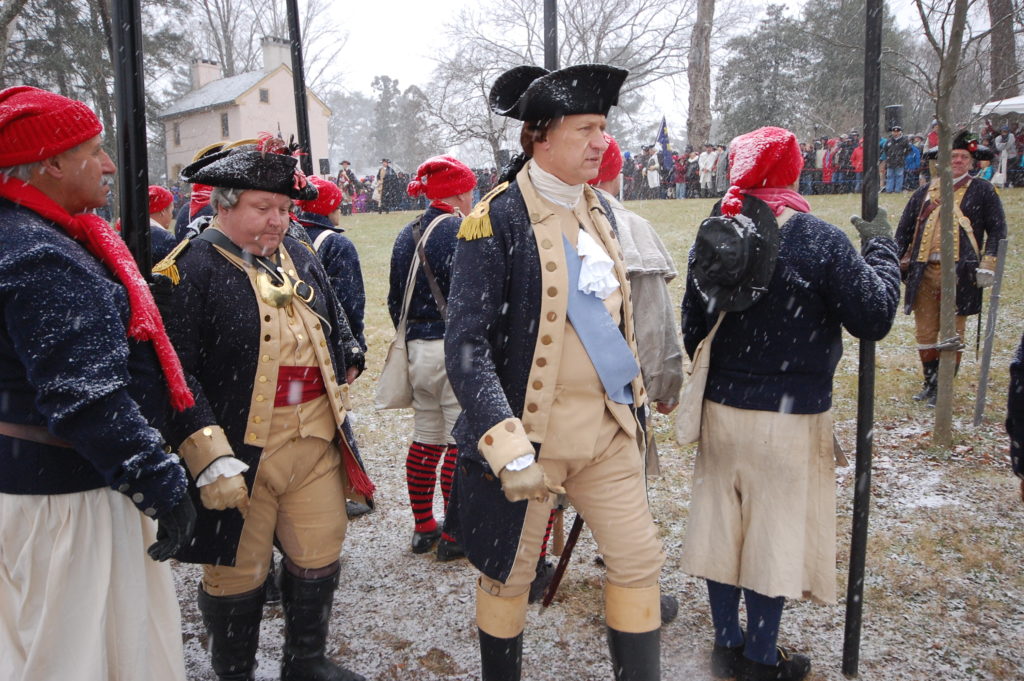
It’s been said that the weather conditions on Christmas night 1776 were terrible for George Washington’s crossing of the Delaware River. But is this just a tale like the well-worn “I-walked-through-a-foot-of-snow-uphill-both-ways” stories today’s adults like to tell children?
Hardly.
The brutal conditions that night are well documented through various diary entries and letters. By all accounts, it was freezing, windy, snowing, and dangerous – a classic winter “nor’easter” that today would send us scrambling to the grocery store for bread, milk and eggs.
A Changing Forecast
Since Washington didn’t have the benefit of Doppler radar in 1776, he couldn’t be sure what the conditions would be like on the night of the crossing. In the preceding days, heavy snow fell and it was cold but the river remained ice free.
Conditions began to change on Christmas morning when floating chunks of ice began to appear in the Delaware River. By that evening, it had begun to snow and what was described as a raw wind began to blow out of the northeast. Snow mixed with sleet and hail and the river began filling with cakes of ice.
Shortly before embarking, a staff officer made a note in his diary: “It is fearfully cold and raw and a snow-storm setting in. The wind is northeast and beats in the faces of the men…the storm is changing to sleet and cuts like a knife.” In an understatement, another soldier wrote that “the weather was uncommonly inclement.”
Colonel Henry Knox, who commanded Washington’s artillery, described the crossing in a letter to his wife on December 28: “Floating ice in the river made the labor almost incredible…Night was cold and stormy; it hailed with great violence.”
Conditions grew so bad that two simultaneous river crossings by soldiers to the south of Washington’s position at McConkey’s Ferry were called off. Washington and his troops were on their own.
An Ongoing Challenge
Against all odds, Washington and his men made it across the river, although they were now running hours behind schedule. Even after the difficult crossing, the weather continued to play a role. A miserably cold and damp 10-mile march on roads slick with ice and snow ensued, and the attack on the 1,500 Hessian troops occupying Trenton took place while hail, sleet and snow fell.
In describing the Trenton fight, author Christopher Ward wrote: “The usual chaos of street fighting was made worse by the fog of gunpowder smoke that hung over the town and by the hail, snow and sleet that continued to beat upon the fighters…The rain soon drenched the weapons of both sides. The flints would not strike a spark; priming charges would not flash; the touchholes were clogged with wet powder.”
Although probably elated with their decisive victory over the Hessians, Washington and his troops faced the long march back to McConkey’s Ferry—with about 900 prisoners in tow no less—and another river crossing back to the Pennsylvania side.
Wrote Elisha Botwick of the 7th Connecticut Regiment: “Our whole army was set in motion and toward evening began to re-cross the Delaware but by obstructions of ice in the river did not all get across till quite late in the evening, and all the time a constant fall of snow with some rain.”
The Challenge Continues
Today, weather continues to play a role in the crossing, but since it’s now a reenactment, the stakes are far lower than they were in 1776. Over the 67 years the reenactment has been held, conditions have ranged from snowy and cold to sunny and downright balmy.
Weather leading up to the reenactment also affects the water level in the river. Some years, a lack of rain leads to a river that is too shallow to float the park’s replica Durham boats. Other years, the river runs too high and fast, presenting a danger to the reenactors.
“The public should understand that today’s reenactors are not professional soldiers, and the fate of America doesn’t hang in the balance if we don’t cross,” says Frank Lyons, who portrays General John Glover during the reenactment. Glover led the Marbleheaders, the seafaring men from Marblehead, MA, who manned the boats during the 1776 crossing.
The ultimate decision on whether it is safe to cross each year is made by the Friends of Washington Crossing Park in collaboration with the park’s manager and the Union Fire Company River Rescue Unit in Titusville, NJ.
Adds Lyons: “If Washington had failed that night, the outcome of the war may have been radically different. It’s disappointing when we can’t cross today, but the safety of the people who keep history alive with this reenactment is most important.”
Let’s hope that Mother Nature doesn’t get in the way of this year’s crossing reenactments, set for December 8 and 25.

